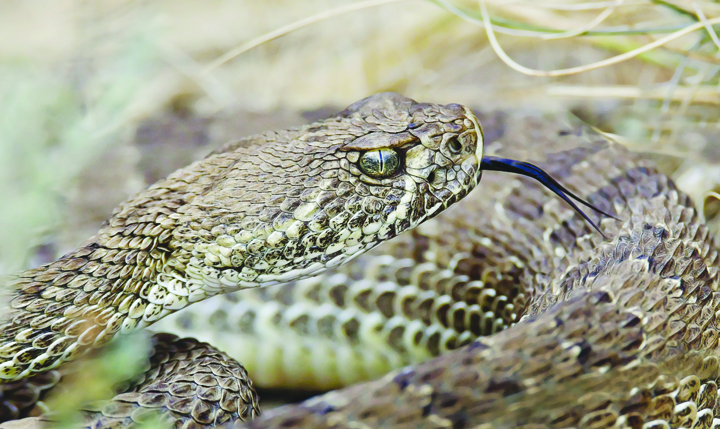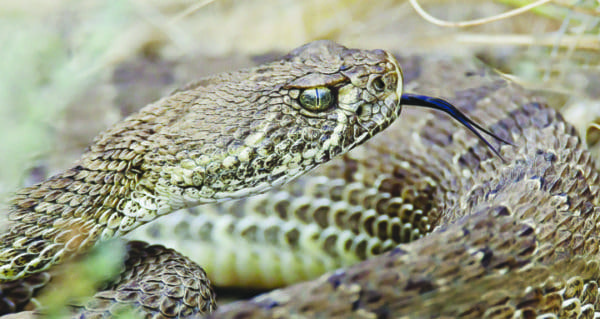
The crotalus viridis, more commonly known as the prairie rattlesnake, is the only venomous snake found on the Canadian Prairies
T. Martin-Schmunk
of the Crossroads
We live in rattlesnake country. My family has encountered several rattlesnakes this summer. It is important for people, visitors and landowners alike, to be snake smart.
Rattlesnakes scare many people. Education is key to understanding these roving reptiles. The main source for factual information throughout this article is aep.alberta.ca. The crotalus viridis, more commonly known as the prairie rattlesnake, is the only venomous snake found on the Canadian Prairies. A protected species, it is typically found in southwestern Saskatchewan and southeastern Alberta.
Environment Canada information states that important habitat requirements include gestation sites, foraging areas, hibernating sites and movement corridors that connect these features. Rattlesnakes are dependent on the same den site every year; they breed and give birth near the den site and return each fall for the winter season.
A suitable habitat includes drier areas of native grassland, often close to a river valley or coulee, farm fields and pastures, rocky areas and sandy soil near rock piles or large boulders.
[emember_protected for=”2″ custom_msg=’For more on this story, please see this week’s print edition of The Cross Roads.’]
Mating occurs during mid to late summer. Females carry developing embryos for about a year, give birth to live young from late August to mid-October. A litter can consist of four to 12 young, each about 11 inches long at birth. Rattlesnakes are active approximately mid-May to late September, hibernating in winter.
Kevin Fitzsimonds, Conservation Officer for the Ministry of Environment in Leader, commented that rattlesnakes are “almost timid creatures; they’ll let you know they’re there.” They coil up in classic defence posture vibrating their tail tipped by a rattle that makes a distinct buzzing sound in warning. Fitzsimonds said that “whenever a snake strikes, it is taking a risk that it will be injured.”
Rattlesnakes hunt by striking rapidly and immobilizing their prey with venom; striking distance is typically two-thirds its body length. Average length is about 36 inches. Prey includes warm-blooded animals including mice, songbirds and voles.
During Fitzsimonds’ 27 years on the job, there have only been two incidents that he was aware of where people suffered from rattlesnake bites. In both of these situations, the person was physically handling the snake. He did recall a number of incidents where pets and livestock suffered from bites, but he never heard of any deaths.
Fitzsimonds reported that his office may receive a couple of calls during the summer to remove a rattlesnake; there have been sightings at the ball diamonds on the west side of Leader and at the River Ridge golf course north of town.
Be snake smart — precautions are key. Be prepared when working outdoors or hiking. Wear sturdy shoes or boots and long pants. Walk in clear areas and avoid tall grass. Use a walking stick. Don’t reach into blind areas. Be on the lookout — rattlesnakes are well camouflaged and blend in with their surroundings. Do not disturb a snake even if it appears dead. Teach children to respect snakes and leave them alone.
Dr. David Torr, Consulting Medical Health Officer for the Saskatchewan Health Authority in our area, confirmed that rattlesnake bites are not common occurrences. He recalled two bites that had happened three or four years ago, cases where people were physically handling snakes.
Anti-venom to treat a rattlesnake bite is not available locally. It is stored in Swift Current, a central location between our area and Grasslands National Park. It is exorbitantly expensive (approximately $4,000 per vial) and requires proper storage. The supply is monitored regularly and because of its expiry date, needs to be replenished every few years. Dr. Torr said that treatment of a bite could use 14 to 20 vials of the anti-venom.
Should a rattlesnake bite occur, Dr. Torr advised of important steps to take. Do not tamper with the affected area. (No tourniquet, no use of ice, no incisions and do not attempt to suck out the poison by mouth.) Immobilize the limb. Remove any rings or jewellery as swelling will occur. Call 911 as soon as possible. Remain calm; less stress will reduce the speed which the venom travels through the blood stream.
The person will be transported to Cypress Regional Hospital in Swift Current; Medicine Hat also carries the anti-venom should that location be preferred. Dr. Torr stressed that in regard to a time frame, the sooner the better and the less complications will arise. There are usually no longterm effects if appropriate care has been taken.
Rattlesnakes are an important link in the food web that by far outweighs the danger to the well-being of humans. Be aware that rattlesnakes are active during mornings and evenings of warm, sunny days; they will often be found on roads, attracted by the heat. They pose no danger when left alone.

